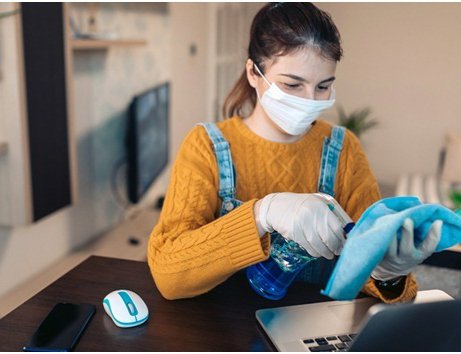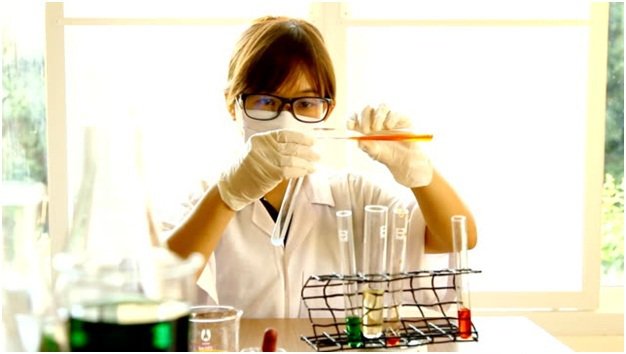
To fight Covid-19 in your homes and offices you must clean and disinfect the areas where you live and work. To prevent and control the spread of the disease, particular attention should be paid to environmental cleaning of high-touch surfaces, such as tables, chairs, kitchen and food preparation areas, refrigerator handles, doorknobs, window handles, light switches, phones, tablets, touch screens, remote controls, keyboards, cabinet handles, desks, toilets, taps, bathroom surfaces, sinks, work surfaces, etc. It is equally important to routinely monitor the cleaning practices and cleanliness, including choice of disinfectant, measuring and mixing of chemicals, their safe handling & storage and proper use of Personal Protective Equipment (PPE).
As long as general environmental disinfection is concerned hypochlorite-based products are highly useful and recommended. They include liquid (sodium hypochlorite), solid or powdered (calcium hypochlorite) formulations. World Health Organization (WHO) determines hypochlorite to be effective against rotavirus at a concentration of 0.05% (500 ppm), however, higher concentrations of 0.5% (5000 ppm) are required for some highly resistant pathogens or viruses.
- Prepare Chlorine Solution from Sodium Hypochlorite Solution
Commercial sodium hypochlorite solutions with different levels of concentration may be readily available for use in a variety of settings (usually with 5% Chlorine Concentration).In non-healthcare settings, sodium hypochlorite (bleach) may be used at a recommended concentration of 0.1% (1000ppm). However, the recommendation of 0.1% (1000 ppm) in the context of COVID-19 is a conservative concentration; therefore a concentration of 0.5% (5000 ppm) is recommended.
To achieve the desired concentration (in this case 0.5% Chlorine), it is necessary to prepare sodium hypochlorite by diluting the basic aqueous solution with a given proportion of clean, non-turbid water to produce the final desired concentration. Please see below for the calculation of sodium hypochlorite concentrations:
1.1 Formula,
[% Chlorine in liquid sodium hypochlorite / % Chlorine desired] − 1 = Total parts of water for each part sodium hypochlorite.
1.2 Example,
[5% in liquid sodium hypochlorite / 0.5% Chlorine desired] -1 = 9 parts of water for each part sodium hypochlorite
Therefore, you must mix 9 parts of water for each part of a sodium hypochlorite solution (5%)to make 0.5% Chlorine solution to be used as a proper disinfectant solution
- Prepare Chlorine Solution from Calcium Hypochlorite Powder
Solid formulations of hypochlorite (powder or granules) may also be available in a variety of settings. Solid formulations are available as concentrated, high-test hypochlorite (HTH) (65-70%) and as chlorine or calcium hypochlorite powder (35%). To produce the final desired concentration (in this case 0.5% Chlorine), the weight (in grams) of calcium hypochlorite that should be added per liter of water can be determined based on the calculation as below:

2.1 Formula,
[% Chlorine desired ∕ % Chlorine in hypochlorite powder or granules] × 1 000 = grams of calcium hypochlorite powder for each liter of water.
2.2 Example,
[0.5% Chlorine desired ∕ 35% in hypochlorite powder] × 1 000 = 0.0143 × 1 000 = 14.3
Therefore, you must dissolve 14.3 grams of calcium hypochlorite powder (35%) in each liter of water to make a 0.5% chlorine solution.
- Safe Handling and Storage of Disinfectants
Since chlorine can rapidly decay in solutions it is recommended to freshly prepare chlorine solutions every day. Likewise, hypochlorite is rapidly inactivated in the presence of organic material; therefore, regardless of the concentration used, it is important to first clean surfaces thoroughly with soap and water or detergent (using mechanical action such as scrubbing or friction) to remove organic matter, followed by the use of disinfecting solution. After sanitizing the surface, when you spray disinfectant solution, a minimum 1 minute of contact time is recommended for it to work properly.
Cleaners should wear adequate PPE and be trained to use it safely. When the solutions are being prepared and used, the minimum recommended PPE includes rubber gloves, eye protection, medical mask, impermeable aprons and closed shoes. The disinfectant and its concentration should be carefully selected to avoid damaging surfaces and to avoid or minimize its toxic effects on people. Be careful, as high concentrations of chlorine can lead to corrosion of metal surfaces and irritation of skin or mucous membrane.
Disinfectant solutions should always be prepared in well-ventilated areas to ensure the circulation of fresh air. You must avoid combining several disinfectants, both during preparation and usage, as such mixtures cause respiratory irritation and can release potentially fatal gases, especially when combined with hypochlorite solutions. Care must be given to store disinfectant solutions in opaque containers (in a well-ventilated and covered area) that is not exposed to direct sunlight. Please don’t forget to keep all the chemicals and solutions strictly out of the reach of children.
(Source: World Health Organization)

Amit K. Shrestha
Shrestha is a freelance Consultant, MS in Risk Control & Safety Management; The author is passionate about the issues involving environment, occupational health, safety and sustainability for the planet, people and profit. Contact Email: OHSNepal@gmail.co
- Preventing Rapid Climate Change: A Hugely Complicated Taskfor Humanity To Tackle
- Oct 29, 2021
- Changing Perception Changes Everything: A Paradigm Shift In Consciousness
- Aug 02, 2021
- Business Continuity Planning And Disaster Recovery: NRB Guidelines For Commercial Banks of Nepal
- Jun 23, 2021
- Fighting Covid-19: Emotional And Mental Wellbeing Of Essential And Frontline Workers
- May 23, 2021
- Fearsome-4 of Construction Industries: Focus on Fatal-Four Hazards
- Jan 27, 2021
















